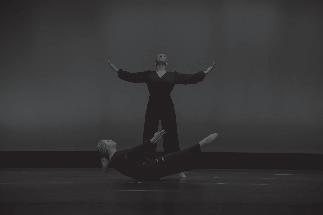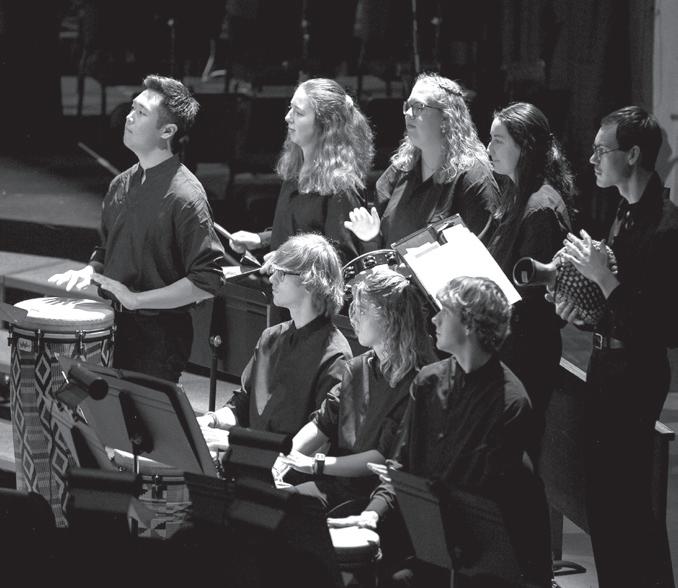A Silent Film by Buster Keaton (1925) Music Selected from the Works



A film projectionist longs to be a detective, and puts his elementary skills to work when he is framed by a rival for stealing his girlfriend’s father’s pocketwatch. While chasing down the suspect, he instead becomes locked in a train car. Upon returning to work, and exhausted from the chase, he falls asleep while screening a film with a similar plot line (but with a stolen necklace) and the ensuing dream sequence is an imaginative romp of daring rescue and sleuthing by the great detective, “Sherlock, Jr.”.
The creation of this accompaniment for Sherlock, Jr. was made possible with the support of a Research and Creativity grant and Sabbatical release from Carthage College. In addition, The Donald and Barbara Gillis Estate and daughter Julie Gillis, provided permissions to recast and arrange this music for the film. Generous support was also provided by Maristella Feustle, librarian at the Special Collections area of the Music Library at North Texas State University.
Complementing the action is the music of Don Gillis, in a score assembled from the composer’s many outstanding works for band. Known for his light hearted compositions, Gillis’ works are a delightful background to the movie. In all, over 60 works by the composer were considered for inclusion in the film, from which 12 were selected. Gillis was a prolific composer, writing ten orchestral symphonies, tone poems such as "Portrait of a Frontier Town", piano concertos, rhapsodies, several works with narration, and six string quartets.
Gillis was born in Cameron, Missouri. His family moved to Fort Worth, Texas, and he studied at Texas Christian University, playing trombone and acting as assistant director of the university band. He graduated in 1935, and obtained a master's degree from North Texas State University in 1943.
He became production director for the radio station WBAP in Fort Worth, later moving to New York where he became producer for the NBC Symphony Orchestra during the tenure of its conductor Arturo Toscanini. After Toscanini retired in 1954, Gillis, serving as president of the Symphony Foundation of America, was instrumental in helping to form the Symphony of the Air, using members of the old NBC Symphony. Gillis also produced the radio program, Toscanini: The Man Behind the Legend, which ran for several years on NBC after the Italian conductor's death.
In 1973 he joined the faculty of the University of South Carolina where he founded, and was chairman of, the Institute for Media Arts and was instrumental in establishing the Instructional Services Center. Dr. Gillis also served as USC's composer-in-residence until his death.
The Land Beyond, from “Saga of a Pioneer” (1959)
Footsie, from “Band Concert” (1958)
The Man Who Invented Music (1950)
Waltz in Waltz Time, from “Band Concert”
The Lazy Days, from “The Land of Wheat” (1959)
Uncle Walt’s Waltz, from “Symphony No. 1” (1952)
Ballet for Band (1955)
The Pioneers, from “Saga of a Pioneer”
The Land and the People, from “The Land of Wheat”
The Pleasant Years, from “Symphony for Band”
America’s Gifted Youth, from “Band Concert”
Men of Music (The New Frontier) (1961, 1966)
Mr. Big (1958)
Threshing Bee, from “The Land of Wheat”
Paul Bunyan, Overture to a Legend (1964, 1967)
The Planting, from “The Land of Wheat”
The Fields in Summer, from “The Land of Wheat”
Addison Kelnhofer
FLUTE
Kaylynn Brewton
Jessica Golden
Mandy Nelson
OBOE
Bella Howard
Toby Staaden
ENGLISH HORN
Laurel Brown
BASSOON
Neil DuJardin
CLARINET
Riley Gaylord
Maya Griffin
Hope Johnson
Emma Lorenz
Grace Miller
Mary Rivas
BASS CLARINET
Madison Bazylewicz
Dontice Wooley
SAXOPHONE
Ava Bartecki
John Cargille
Jalen Imroth
Jana Paulsen
Zach Shoemaker
Michael Aylward
Ella Christensen
Lanie Klawonn
Ellamae Monk
TRUMPET
Bailey Dobbratz
Nathan Esboldt
Elliot Podratz
Luke Rodriguez
TROMBONE
Anita Gross
Johnathan Ledanski
Jake Muller
Andrew Schaer
EUPHONIUM
Braedon Larson
TUBA
Riley Betthauer
Oliver Juarez-Wunderlin
PERCUSSION
Cora Brown
Avery Conger
Cece Cooper
Lydea King
Emma Libecki
Davian Santiago
Drake Thomas
PIANO
Alasdair Ladd
The Carthage College Wind Orchestra, established in 1873, is one of the oldest college bands in the United States. From its humble beginnings as a six-piece brass ensemble, the group has grown in size and stature to assume a leadership role for wind music on an international level. The band has a long and honored history of service to Carthage College and the artistic life of the communities of Kenosha, Wisconsin and Carthage, Illinois. On October 21, 2017, the Wind Orchestra returned to Carthage, Illinois to perform a concert celebrating the 500th anniversary of the Lutheran Church with a concert in the old college auditorium, recently refurbished and now known as “The Legacy Theater”. The 140th Anniversary was celebrated with many events, beginning with an outdoor performance of music drawn from the 1873- 1874 programs and concluding with the May Anniversary Concert that featured the premiere of Liquid Compass by Alex Shapiro. Our 150th Anniversary in 2023-24 was marked with the World Premiere of a work by Timothy Mahr celebrating the rich history and student contributions to its success, Fortitude. In 2025 the Wind Orchestra was recognized as one of the premiere small college bands in the country by the College Band Directors National Association at their national convention in Fort Worth, Texas.
The Wind Orchestra made their seventh visit to Japan in January 2024 as part of an ongoing exchange program with Kurashiki Sakuyo University School of Music, and will be returning in January 2027. Carthage continues to be active in the areas of commissioning new works, including Jennifer Higdon’s Aspire, Stacy Garrop’s Quicksilver and Mythology Suite, Andre Previn’s Music for Wind Orchestra, Dana Wilson’s Concerto for Trombone and Tuba Concerto, Soliloquy for Solferino by Martin Ellerby, and most recently a work for organ and winds by Graeme Shields, Rubrical Expressions.
The Carthage Wind Orchestra is not only an exceptional performance ensemble, but a live, interactive “learning laboratory” for music education students as well. Those students in the music education program have opportunities to conduct and rehearse the band, and receive guidance and feedback from the conductor and ensemble members. Rehearsals are structured to lend insight into how to make music, along with how to teach music.
Why a wind orchestra? The ability to change the sound of the ensemble based on the composer’s intent and musical style period is at the heart of the wind orchestra philosophy. The wind orchestra layers the timbres of each instrument, rather than mixing them for a more colorful effect. Maybe most importantly, the wind orchestra places optimal value on the expressive contribution of each member.






music at carthage
At Carthage College, you will study with exceptional faculty who set high expectations for the unique, creative individual you are. Whether you’re interested in music performance, music education, or musical theatre, the opportunities at Carthage are limitless.
music visit day: Thursday, Dec. 4
audition dates:
Nov. 14
Nov. 15 Jan. 31
Feb. 7 Feb. 14 Feb. 21


programs of study
bachelor of arts
Music

Music: Composition
Music: Performance (Vocal, Instrumental, Piano)
Music: Piano Pedagogy
Musical Theatre
Playwriting
Technical Direction
Technical Stage Management
Theatre
Theatre Education, K-12 Licensure
Theatre Performance
bachelor of music
Music Education (Instrumental and Vocal, K-12)
Musical Theatre
Piano Performance and Collaborative Piano
minors
Dance Music
Musical Theatre Theatre
master of music
Music Pedagogy
Music Theatre Vocal Pedagogy
Fall Dance Show- Everything You Touch
Friday, November 14 • 7:30 p.m.
H.F. Johnson Recital Hall
Student Recital: Jana Paulsen
Tuesday, November 18 • 7:30 p.m.
Recital Hall
Concert Band/ Percussion Ensemble Concert
Wednesday, November 19 • 7:30 p.m.
A. F. Siebert Chapel
Christmas Festival
Friday, December 5 • 7:30 p.m.
A. F. Siebert Chapel
"Speakeasy" Gradate MT Recital
Friday, Feburary 6 • 4-10 p.m.
Wartburg Theatre
Arts at Carthage acknowledges that the land on which our building stands is part of the traditional Potawatomi, Sioux, Peoria, Kickapoo, and Miami peoples past, present, and future. These homelands reside along the southwest shores of Michigami, North America’s largest system of freshwater lakes. We honor with gratitude the land itself, and the people who have stewarded it throughout the generations. Many Indigenous peoples thrive in this place—alive and strong, and this calls us to commit to continuing to learn how to be better stewards of the land we inhabit as well.